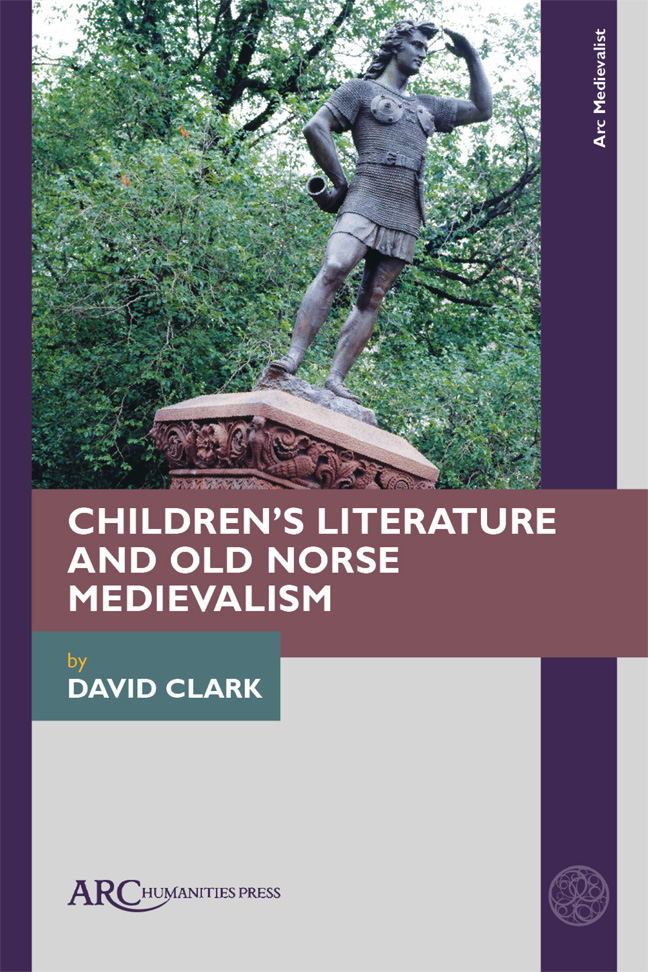Book contents
- Frontmatter
- Contents
- Acknowledgements
- Dedication
- Introduction: The End
- 1 Age-Related Categories
- 2 Generic Categories
- 3 Transformational Fantasy
- 4 Horned Helmets and Comic Anachronism
- 5 Viking Reputation
- 6 Runes and Magic
- 7 The Power of Story
- 8 Race and Ethnicity
- 9 Heroism
- 10 Viking Masculinity
- 11 Viking Femininity
- 12 Viking Sex and Gender
- 13 Bowdlerization
- 14 Sexuality
- 15 Ecological Threat
- 16 Norse Medievalism in Alan Early's Father of Lies Trilogy
- 17 Avoiding the End of Days: K. L. Armstrong and M. A. Marr's Blackwell Pages
- 18 Rick Riordan's Magnus Chase Series and Norse Medievalism
- Conclusion
- Select Bibliography of Frequently Cited Works
- Index
1 - Age-Related Categories
Published online by Cambridge University Press: 17 February 2024
- Frontmatter
- Contents
- Acknowledgements
- Dedication
- Introduction: The End
- 1 Age-Related Categories
- 2 Generic Categories
- 3 Transformational Fantasy
- 4 Horned Helmets and Comic Anachronism
- 5 Viking Reputation
- 6 Runes and Magic
- 7 The Power of Story
- 8 Race and Ethnicity
- 9 Heroism
- 10 Viking Masculinity
- 11 Viking Femininity
- 12 Viking Sex and Gender
- 13 Bowdlerization
- 14 Sexuality
- 15 Ecological Threat
- 16 Norse Medievalism in Alan Early's Father of Lies Trilogy
- 17 Avoiding the End of Days: K. L. Armstrong and M. A. Marr's Blackwell Pages
- 18 Rick Riordan's Magnus Chase Series and Norse Medievalism
- Conclusion
- Select Bibliography of Frequently Cited Works
- Index
Summary
WHILST THE CATEGORIES of child and adult may be problematic, in practical terms children's literature usually forms a distinct section of the shelves of our rapidly vanishing bookshops and libraries, and it constitutes a distinct category in online stores. Since both children's and YA literature encompass most other forms of literature, how-ever—from litfic, science-fiction and fantasy, detective and romance novels to poetry and non-fiction of various kinds—they are if anything meta-genres and the genres they contain are themselves problematic and overlapping. The best approach, perhaps, is to invoke the mathematical concept of “fuzzy sets,” and acknowledge categorical distinctions as bumpy vehicles designed with critical convenience in mind.
Publishers tend to divide children's books into marketing brackets by format and/or age, and this kind of order also often prevails on the shelves of bookshops and libraries, whether in physical or metaphorical (online) form. This therefore provides one way into contemporary Norse medievalisms. I divide them loosely by age into board and picture books for the earliest readers, titles aimed at younger children, older children and Young Adult. They are sometimes subdivided into much smaller categories, but there is no consistency here from publishers, marketers, bookshops, libraries, or writers. As the age of the intended audience increases, it is fair to say that the books generally increase in length, complexity of plot and character, sophistication of language, and “darkness” of potential theme. I look at titles with an overarching narrative rather than non-fictional histories or related but distinct media with their own conventions such as graphic novels. I also focus on one or two particularly interesting examples to represent each category.
Board and Picture Books
Board books are usually aimed at the very youngest children (up to around four years old) and may also overlap with what might be called novelty books: books which also function as toys or contain an interactive element. A charming example here is Gabby Goldsack's What's in Viking Vic's Long Grey Whiskers? (1998). This book consists of ten unnumbered pages on board, with a horned-helmeted head protruding from the last page. From this head, grey threads hang down over the other pages to form Vic's whiskers; the child reader must locate Vic's tools in his beard so that he can build his boat and set sail.
- Type
- Chapter
- Information
- Children's Literature and Old Norse Medievalism , pp. 17 - 26Publisher: Amsterdam University PressPrint publication year: 2023

